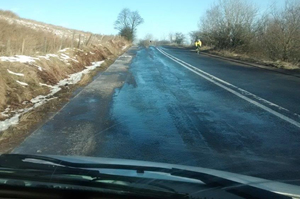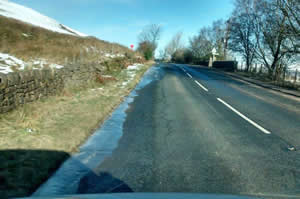Travelling safely
Despite our best efforts, winter weather can still make roads treacherous and there is no guarantee that roads will always be completely free of ice and snow. The key to safer driving, riding or cycling this winter is to make sure you and your mode of transport are fully prepared and to make sure you always travel with due care for the weather and condition of the roads.
Unexpected icy patches
When driving in icy or snowy weather, remember to drive carefully and very slowly.
 Never assume a road has been gritted. Be prepared for the road conditions to change over relatively short distances.
Never assume a road has been gritted. Be prepared for the road conditions to change over relatively short distances.
Icy stretches can suddenly develop on treated and untreated surfaces caused by water running off fields onto the road, or other sources.
These icy patches can be hard to spot especially if there is dazzle from winter sun and black ice can hardly be seen at all.
Icy patches can particularly be dangerous for motorcyclists and cyclists and you need to decide whether your journey is essential. See our advice for motorcyclists and cyclists.
 Cyclists also need to watch out for ice forming in channels which can spread into the road.
Cyclists also need to watch out for ice forming in channels which can spread into the road.
We put up 'Beware Ice' signs where we know about these icy patches on the roads we treat but we can't identify them all so please be constantly alert and looking out for them.
Parking your vehicle during winter
If you park your car on a main road or gritting route during winter, please make sure it's not causing an obstruction. Blocked roads could mean we are unable to grit or grit that road and could also mean your vehicle is at risk of damage if our gritters have to manoeuvre around your vehicle.
Let us know
Keep up-to-date
- Latest gritting updates
- Follow #LancsWinter on Twitter *
- Highways updates *
- Met Office forecast *
- Met Office Weather Ready campaign *
- Are you prepared? leaflet (PDF 689 KB)
* External links
Park responsibly for our gritters
Graham from our highways team tells us more about parking safely.